Menu
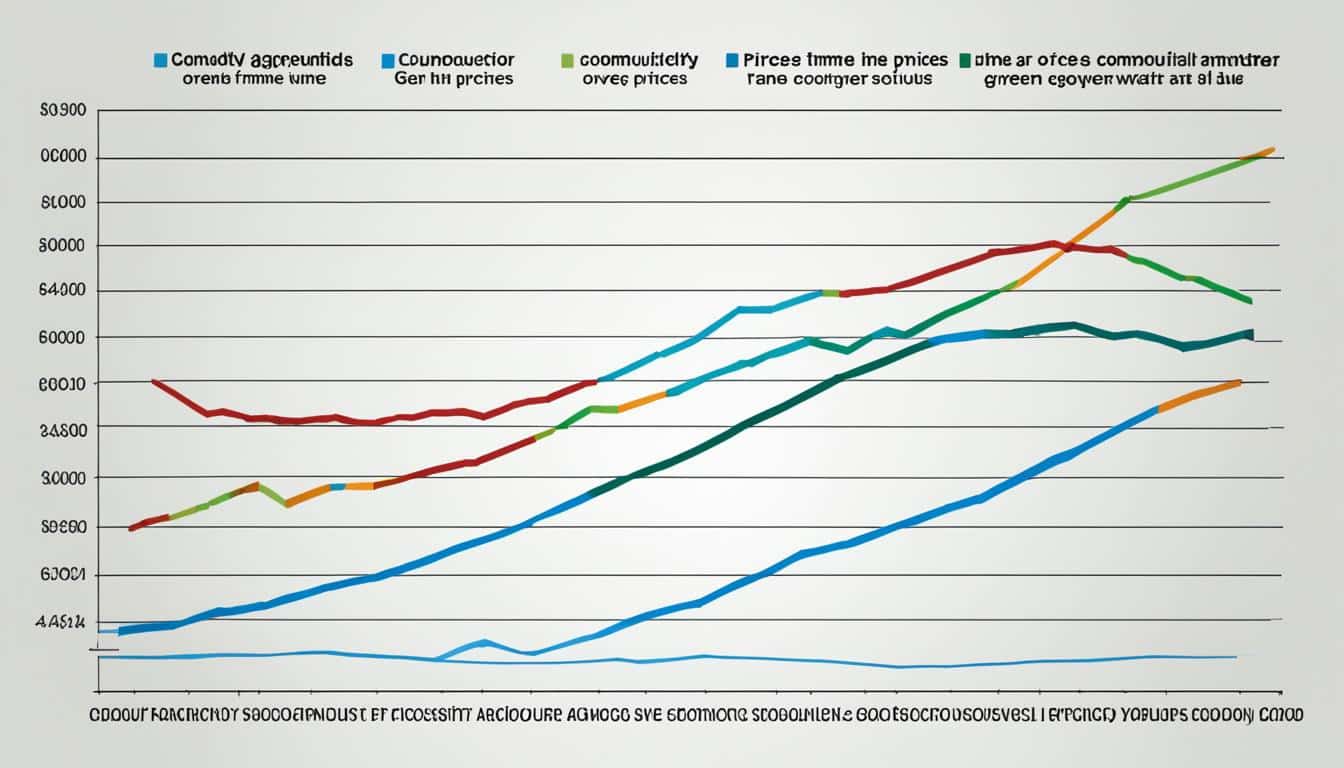
Agricultural commodities often have prices that jump up and down a lot. This happens when there’s not enough, or too much of a product. Weather, how much people need or want the product, and global trading change prices. This can mean farmers and those who work in the industry make less money sometimes. Knowing how to guess where prices will go is really important in today’s market. Climate changes, big world events, and what people want to buy are key.
Understanding and guessing these price changes is super important. It lets farmers, traders, and those who make rules make good decisions. These decisions can help take down risks and keep money steady. A lot of things can affect prices, like bad weather, rules about trading with other countries, and problems buying what you need to grow crops. So, being able to look ahead and plan is a must-do in farming.
Let’s learn more about market trends, how up and down prices affect things, and smart ways to guess what’s coming. Getting the hang of these changes is key to doing well in the farming business.
Agricultural commodity prices are key in the world’s economy. They affect everyone from local farmers to international traders. Knowing the basics of predicting prices can lead to better decisions, risk management, and policies to keep markets stable.
Commodity price forecasting predicts future prices of important farm products. It helps those in agriculture make choices and deal with market changes. For example, knowledge of agricultural economics lets experts understand market trends. This knowledge helps in making important decisions like when to plant and where to invest.
Many things affect the prices of farm goods. These include:
Using both technical analysis and understanding the basics of these factors can help those in the agriculture industry. It allows for better prediction of market changes. This leads to smarter, more strategic decisions.
Predicting agricultural prices helps manage market ups and downs. This skill is critical for reducing risky impacts. We look into methods like fundamental and technical analysis or machine learning for this.
Experts look at important details and mixed methodologies for forecasting. They consider both personal insights and lots of data. Each method looks at economics from a different angle, making it easier to adapt to changes.
For example, ARIMA can make good short-term predictions. Meanwhile, grey models work well when long-term trends are clear.
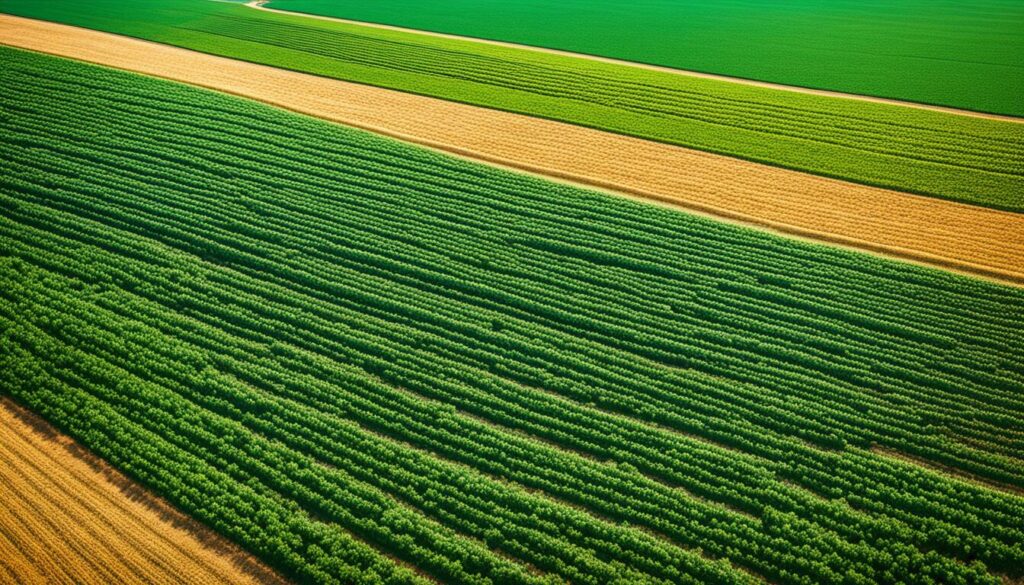
Even with advanced techniques, agricultural forecasting faces hurdles. Limited or complex data can make usual models less useful. Advanced computing is needed for the best results.
Natural disasters, government decisions, or diseases can quickly change prices. This makes predicting costs accurately very tricky. But, using smart analytics can help improve the forecasts, giving advice to those in the market.
| Technique | Strengths | Weaknesses |
|---|---|---|
| Regression Analysis | Common; easy to understand | Overfitting; underfitting; issues with change |
| Time Series Analysis | Useful for seeing short-term trends | Not as good for the long-term future |
| Machine Learning | Very accurate; can be used widely | Needs a lot of power; lots of data |
| Grey Model (e.g., GM, DGM) | Good for looking far ahead with less data | Needs data trends to be obvious and regular |
Weather and climate change are key in setting crop prices. Temperature and rain change crop growth a lot, which shifts market prices. A study from 2008 to 2020 shows how food prices change as temperatures do.
Weather matters greatly for how much food we get. High temperatures, oil prices, and food exports can push food prices up. Nigeria relies heavily on rain for its food, and about 80% of its crops need it.
In Nigeria, growth is affected by these weather changes. Its economic output in 2022 was nearly USD 535 billion, but it faces big challenges. The way things are going, global food needs will increase a lot by 2050. But the increase in crops isn’t keeping up with the people.
One third of all food made is either lost or thrown away. This makes food insecurity worse for 30% of the world. Nigeria is hit hard by heatwaves, droughts, and floods. Action is needed now to tackle the growing effects of climate change on food.
| Impact Factor | Effect on Prices | Regional Focus |
|---|---|---|
| Temperature Variability | Stimulates food prices at higher quantiles | Global |
| Monetary Expansion | Influences agricultural commodity prices | Nigeria |
| Climate Change (Heatflation) | Compresses crop yields | Nigeria |
| Food Exports | Affects market dynamics | Global |
| Global Warming Conditions | Risk of yield decline by 2100 | Global |
The world’s trade and the choices we make at home hugely affect how much things cost. This is very true for farming products. Whether it’s the price of an avocado in London or rice in India, local and global factors are at play.
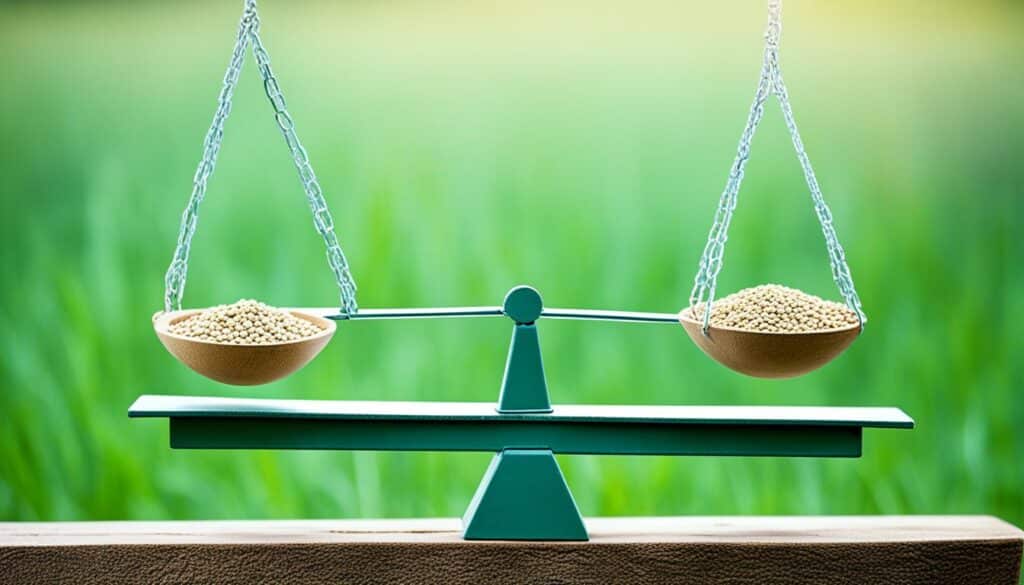
Across the globe, trade shapes what we pay for food and other agricultural items. When something changes in one place, it can be felt everywhere. For example, the strength of the US dollar can change the cost of goods worldwide. This, in turn, affects the economy in places like Africa. While expensive goods can help for a bit, they often don’t lead to long-lasting wealth.
How we buy things and what we grow locally has a big impact too. Take Pakistan, for example, where farming is a major part of life and the economy. Nearly two-thirds of Pakistanis work in farming. So, if the country makes less wheat or cotton, it affects a lot of people. Recent drops in these crops show just how much change can happen because of local events.
| Key Agricultural Crops | Production Changes (2022) |
|---|---|
| Wheat | −3.9% |
| Cotton | −6.8% |
Changes in how we loan money to farmers or react to weather can also shake things up. For example, giving more loans to farmers might help a country grow. But, if food prices go up too much, it could slow everything down. And we can’t forget about the weather. It’s often unpredictable and can cause big swings in how much food costs.
It’s important to see the big picture. Global and local effects together change how much we pay for food. Whether you work in agriculture or just care about prices, knowing these links can help us understand and predict changes. This way, we can all make smarter choices.
Government rules have a big impact on food prices. The 2018 Farm Bill brought in support schemes to help farmers. These included Price Loss Coverage (PLC), Agriculture Risk Coverage (ARC), and the Marketing Assistance Loan Program. These rules are there to keep prices stable and help farmers.
PLC helps farmers when prices for key crops drop below a set level. It covers crops like wheat, corn, barley, and soybeans. Farmers can also update their PLC yields every year to keep up with changes in their crops.
ARC supports farmers based on their past production of key crops. This helps manage risks, as the support is linked to what they’ve grown before. It’s a crucial part of the farming economy, making sure farmers have some financial safety even when times are tough.
Aside from these, many other rules and support systems have been set up over time. For example, the 1996 Farm Bill stopped forcing farmers to reduce their land, moving towards more flexible payments. This was later changed to direct payments with the 2002 Farm Bill. The 2014 Farm Bill then shifted away from direct payments to focus on the PLC and ARC programs.
All these rules mean those watching the agricultural market must always be alert. Changes in policy can affect prices hugely and influence a complex system of support. With good use of both old and new data, experts can forecast how these policies might change prices in the future.
| Commodity | PLC Eligibility | ARC Revenue Criteria |
|---|---|---|
| Wheat | Yes | Actual county revenue falls below guarantee |
| Corn | Yes | Actual county revenue falls below guarantee |
| Soybeans | Yes | Actual county revenue falls below guarantee |
| Barley | Yes | Actual county revenue falls below guarantee |
It’s vital to understand how government policies and rules impact food markets. By constantly studying these support schemes, experts can make better predictions. This helps everyone involved in farming and food to be ready for what’s ahead.
It is crucial to understand inflation’s effect on agricultural goods today. Across the economy, inflation uniquely changes how agricultural products are priced. This increase in costs can reduce profits for those in farming.
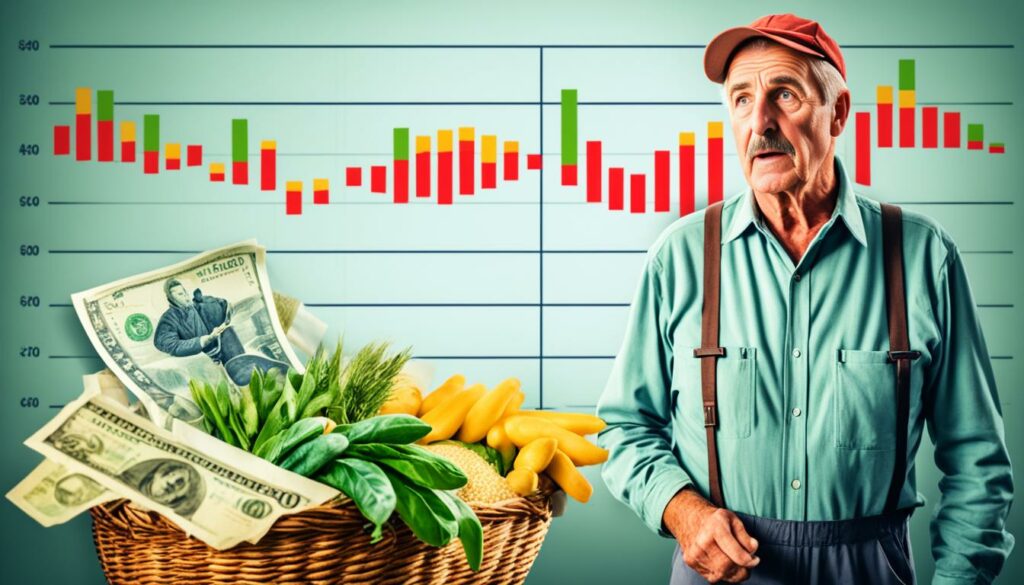
Inflation leads to higher input costs, a major issue for agriculture. For example, fertiliser prices have soared, sometimes tripling. This surge in costs is seen not only in fertilisers but also in feed and fuel. As these inputs become more expensive, farmers find their profits squeezed even tighter.
Increased costs travel down the supply chain to impact farm produce prices. Between February 2020 and May 2023, food prices jumped by 23.5%. By June 2022, consumer prices hit a 9.1% increase, the highest in 40 years. These numbers show why raising farm produce prices is necessary for farmers dealing with inflation.
Inflation and rising inputs create a complex situation for agricultural commodities. In 2023, the inflation rate lowered, but the sector is still feeling the effects. The recent Russia-Ukraine conflict and other geopolitical events are making matters worse. They are leading to higher prices for products like wheat and fertilisers.
Looking forward, commodity prices, especially for grains and oils, started rising in early 2024. This hints at a shift from the 2023 price decreases. Farmers and others in the industry must stay alert and adjust their strategies. They need to manage through the ongoing challenges posed by inflation’s effect on farm produce prices.
In the world of agricultural prices, predicting trends is key. Many tools help, from old ways to new tech.
Fundamental analysis looks at things like supply, demand, and costs. It helps us understand why prices change. For example, labour costs and the global market play big roles. At the University of Nebraska-Lincoln, the course AECN 436 teaches these important ideas. It helps students learn to use supply and demand to forecast prices.
Technical analysis finds patterns in price history. By looking at charts, it guesses what prices might do next. This is very good for the weird ways agricultural prices move. Traditional models can’t always handle this.
Now, machine learning and data analytics change everything. They can predict prices well, using things like VAR and neural networks. For instance, a VAR model can guess live pig prices in the short term. But, it’s not as good with long-term guesses. There’s also a promising method to predict veggie prices in China.
But, experts’ views are still very important. They add depth and catch things data might not. They talk about how weather, policies, and diseases affect prices. This helps make forecasting more complete.
By using many techniques together, a solid forecast model can be made. This helps deal with the ups and downs of the market, aiding smart choices.
Agricultural commodity prices follow a cycle that’s key for those involved. This cycle helps us see where corn and soybean prices might go. Knowing this, we make better choices when selling grains, boosting our profits.
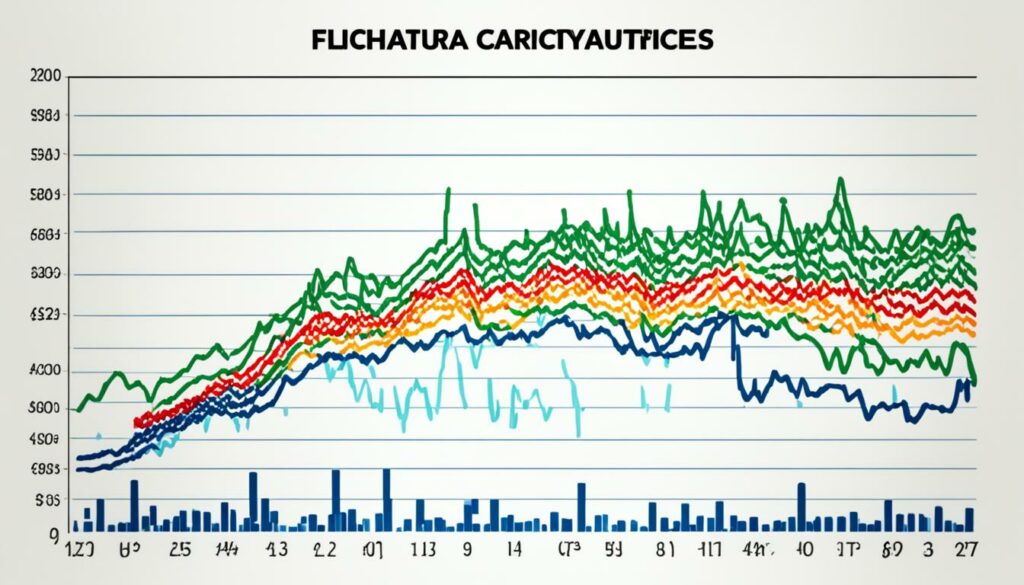
In the U.S., grain prices change throughout the year because of harvest times. For corn, prices fall in autumn when there’s a lot to harvest. They then rise in early summer when supplies go down. Soybean prices work the same way, dropping in the autumn and picking up before the next harvest.
Farms can do better by understanding these changing prices. By selling in advance, they often get higher prices than at harvest. This strategy means they have crops to sell when prices are better. It’s all about knowing when to act to earn more.
Looking at past years shows how outside factors can affect corn and soybean prices. Usually, corn prices drop in autumn, but 2020 was different. That year, prices shot up because of droughts, a weaker US dollar, and smaller crops in South America.
When soybeans are harvested in South America in February, U.S. prices can change. This yearly event can cause prices to fluctuate. Unlike the typical 12-month cycle in the U.S., these events are not as predictable and depend more on what’s happening around the world. These factors can really shake up the usual pricing patterns.
| Year | Corn Prices ($ per bushel) | Soybean Prices ($ per bushel) |
|---|---|---|
| 2023 | 4.80 | 12.75 |
| 2024 | 5.00 | 12.80 |
Looking closely at years with small harvests is very important. By tracking price changes, we can know when and how prices will go up or down. This is essential for planning how to sell grains to make the most money.
In the world of farming, it’s crucial to handle price volatility. This helps keep our money safe. The poor in many places spend most of their income on food. So, the risks are high for them. Farmers and investors must plan carefully to deal with price changes well.
Dealing with price changes is key because they can be hard to predict. One smart way is through financial hedging. This uses other financial tools to lessen the risk of prices going up. Businesses may also make deals for a set price in the future or cap how high prices can go.
Hedging means taking a counter position in the market to balance out risks. Using futures contracts, farmers can keep their crop prices steady. This protects their income from sudden market changes. Other businesses are also mixing futures, swaps, and options with how they manage costs to lower risks.
Some businesses make long-term deals with suppliers for set prices or with maximum price changes. This helps them manage cash flow better. They might also change how they make or deliver products to need less of the uncertain materials.
Knowing the market, keeping up with real-time price data, and negotiating well with suppliers are all crucial. For example, seeing how global oil prices affect food prices can teach a lot about big market trends. This shows how being informed is vital for making good choices in farming.
Geopolitical events greatly affect agricultural commodity prices and market trends. They can cause sudden and serious disruptions. Such events range from international conflicts to political dramas. These can change trade deals and the global supply process.
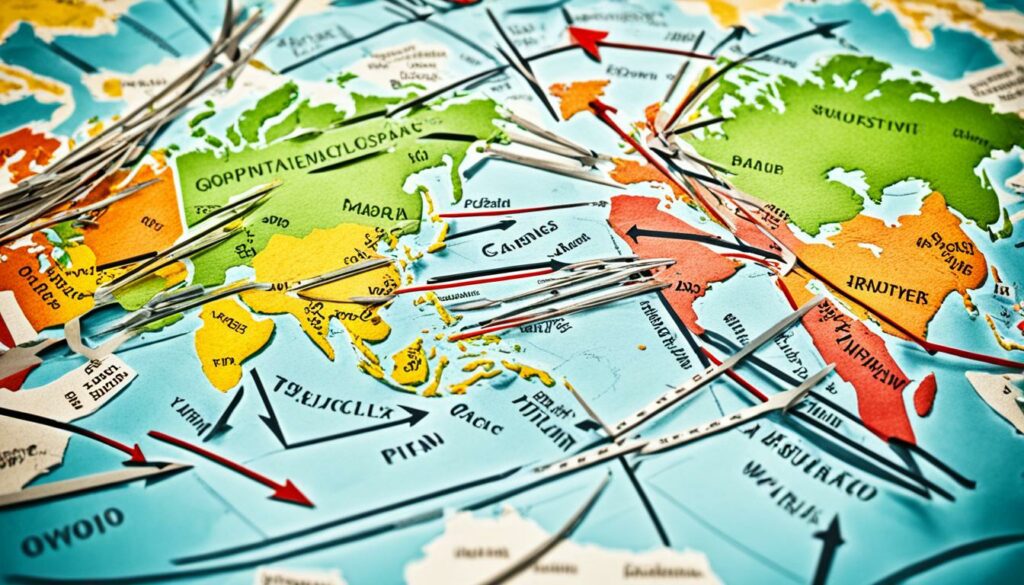
The COVID-19 pandemic and the Russia-Ukraine conflict spiked the connection between commodity market returns by 52.90%. This affected 16 goods, including energy, metals, and agriculture. Natural gas and crude oil were linked, showing how one can influence another.
Looking at return and volatility impacts, different commodities respond uniquely to geopolitical crises. For example, oats showed huge fluctuations, while lead’s changes were less pronounced. Oil mostly affected the price shifts, with fuel oil being most impacted.
Geopolitical conflicts can significantly change food prices. This can make agricultural markets unstable. In 2022, about 2.4 billion people, roughly 29.60% of the global population, faced food insecurity. Geopolitical conflicts disrupt food production and shipment, increasing the risk.
Some countries stopped exporting food to keep local prices stable, worsening food shortages globally. As tensions rise, world financial markets can become unpredictable. This pushes up food future prices, making markets more volatile.
In some poor countries, these events can have a dangerous effect, impacting their food supply directly. Studies on wheat, maize, soybean, and rice have shown how geopolitical risks hit the food market. Models suggest these hits are severe, causing sharp and lasting fluctuations in prices.
| Commodity | Own Return Spillovers (%) | Cross Return Spillovers |
|---|---|---|
| Oats | 80.91% | – |
| Lead | 32.51% | – |
| Natural Gas | – | Crude Oil |
It’s evident that geopolitical events quickly and deeply alter agricultural commodity prices. Those in the market must carefully watch and understand these changes. Doing so is key for those aiming to reduce risks in the agricultural commodities sector.
Technological advancements are changing the farm world for the better. They offer new ways to boost output, cut costs, and keep prices steady. The use of precision agriculture with smart data analysis is leading this change.
Precision agriculture is a big step forward for farms. It uses tech to watch and improve how we manage fields, especially for growing crops. On corn farms, using yield monitors has gone up a lot, from 19% to 52% between 2001 and 2016.
This change has helped increase corn yield by over 40% since 1996. Also, variable-rate fertiliser use rose from 6% to 19%. This means nutrients for the soil are put down better and more cheaply.
These moves up the productivity and help manage crop prices. Farms with more tech saw their costs per acre double from 1996 to 2016. But, the smarts brought by tech often cut the total cost per bushel down.
Data analytics is key for getting the most out of precision agriculture. By crunching big data, farmers can smartly handle crops, seeding, and fertilisers. Nitrogen use increased from 107 to 125 pounds per acre from 1996 to 2016 thanks to detailed analysis.
Using analytics isn’t limited to the fields. It also helps foresee crop prices. With huge data, farmers can guess prices better. This makes managing the rising cost of seeds–up by 263% since 1996–easier, keeping farms stable.
As farming tech evolves, precision agriculture and data analytics will be crucial. They will keep on boosting efficiency and balancing crop prices. For details on how seed and tech innovations are making farms better, check here.
Farmers need strong strategies to handle price ups and downs. They should plan well and manage their money wisely. This is because market prices change a lot, mainly due to things like the weather, what consumers want, and trade rules. Using the right tactics is key to staying profitable and stable in farming.
For farmers, planning what to produce is vital when prices are uncertain. They can boost their crop yields and cut down on waste by using high-tech farming methods. It also helps to grow different crops or raise various livestock to spread the risk.
Meeting the trends in what people want, like organic or plant-based foods, is smart. It creates chances to sell more. By taking these steps, farmers are ready to grab opportunities or face hard times in the market.
Keeping control of their finances helps farmers deal with variable prices. This means looking into risks and working with insurance to protect their farms. They can get an edge by using new tech tools for predicting prices and increasing transparency with blockchain.
Building up partnerships can also make them stronger. Sharing advice and resources with others can help everyone do better. With these methods, farmers can handle financial risks, improve their plans, and make more profit.
These prices show how much things like grains, fruits, and veggies are sold for. They change based on how much is available, the weather, and big world events.
Predicting prices helps farmers, traders, and others plan. It allows them to make smarter choices and reduce risks. This way, everyone can work towards keeping prices steady.
There are many things. Weather, supply and demand, global trade, and even local rules and costs can change prices. Inflation and climate issues also have big effects.
People use a mix of methods. They look at the big picture, use machines to learn from data, and talk to experts. All this helps guess what might happen to prices.
It’s not easy. There’s not always enough data. Prices can jump around a lot. And there are lots of things to consider, like the weather and what’s happening in the world.
The weather can change how much food we get. If this happens a lot because of climate change, prices could go up or down. This makes understanding price changes very important.
Trade between countries changes how much food is available. This then affects the prices. The world is so connected now that prices are influenced by what happens in different places.
The things governments do can really change prices. For example, giving money to farmers or making trade deals. It’s important to watch these changes to guess what might happen to prices.
When prices in general go up, it costs more to make food. This usually means food prices also go up. It’s not just the food itself; the tools and machines needed to make it can get more expensive too.
Experts use many ways to guess future prices. They look closely at things, like the markets, use machines to find patterns, and ask other experts. All these ways help them make educated guesses about future prices.
The time of year can change food prices a lot. For example, grains might get cheaper or more expensive at different times. Learning about these patterns can help people make smart moves in the market.
There are ways to deal with changing prices. Things like hedging and futures contracts can help reduce the risk for farmers and investors. These methods are used to protect against sudden price changes.
Big world events can shake up food prices. Things like wars or big political changes can really affect the markets. It’s key to watch out for these events as they impact food cost changes.
New tech is changing farming a lot. It’s making crops grow better, helping to guess prices more accurately, and managing prices well. All this makes farming smarter and more predictable.
To deal with changing prices, farmers can plan carefully. They should think about what and how much to produce. Then, with smart marketing and production plans, they can still make good money even if prices change a lot.